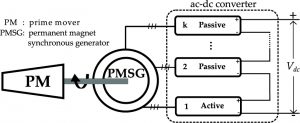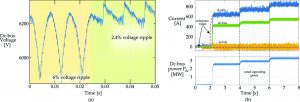Development of Control Algorithms for an Integrated Generator-Rectifier System
Pd D student Phuc Huynh with advisor A. Banerjee
Ac-to-dc power conversion is essential in many emerging applications, including electrified transportation and wind-power generation. For example, an intermediate dc bus is often necessary to connect a variable-speed wind-powered generator to the fixed-frequency ac grid. Similarly, future electric ships are envisioned to have a medium-voltage dc grid created from a gas-turbine-driven ac generator. This project, supported by Banerjee ICR funds, develops an architecture, as shown in Figure 1,

Figure 1, Proposed integrated generator-rectifier architecture with one active rectifier serially connected with multiple passive rectifiers. Power-flow control of the
system is achieved through controlling the active rectifier.
integrating active with passive rectifiers to a permanent-magnet synchronous generator for ac-to-dc power conversion. With extensive use of passive rectifiers, the goal of reduced investment cost, reduced loss, and improved reliability can be achieved.
Since mid-2018, the project has focused on developing control algorithms for the proposed architecture. The first algorithm aims to eliminate the dc-side filter capacitors of the passive rectifiers. Eliminating the filter capacitors significantly reduces system size, weight and cost, and improves overall reliability. This goal is achieved by controlling the active rectifier power flow to create a dc-side voltage that compensates the ripple voltage caused by the passive rectifier, as shown in Figure 2 (a). The second algorithm aims to perform maximum power point tracking (MPPT). Feasibility of performing MPPT is essential for application to wind-energy harvesting. MPPT can be achieved though generator torque or electrical power control. These two types of control are obtained through commanding d-axis current of the active rectifier, as shown in Figure 2 (b).
